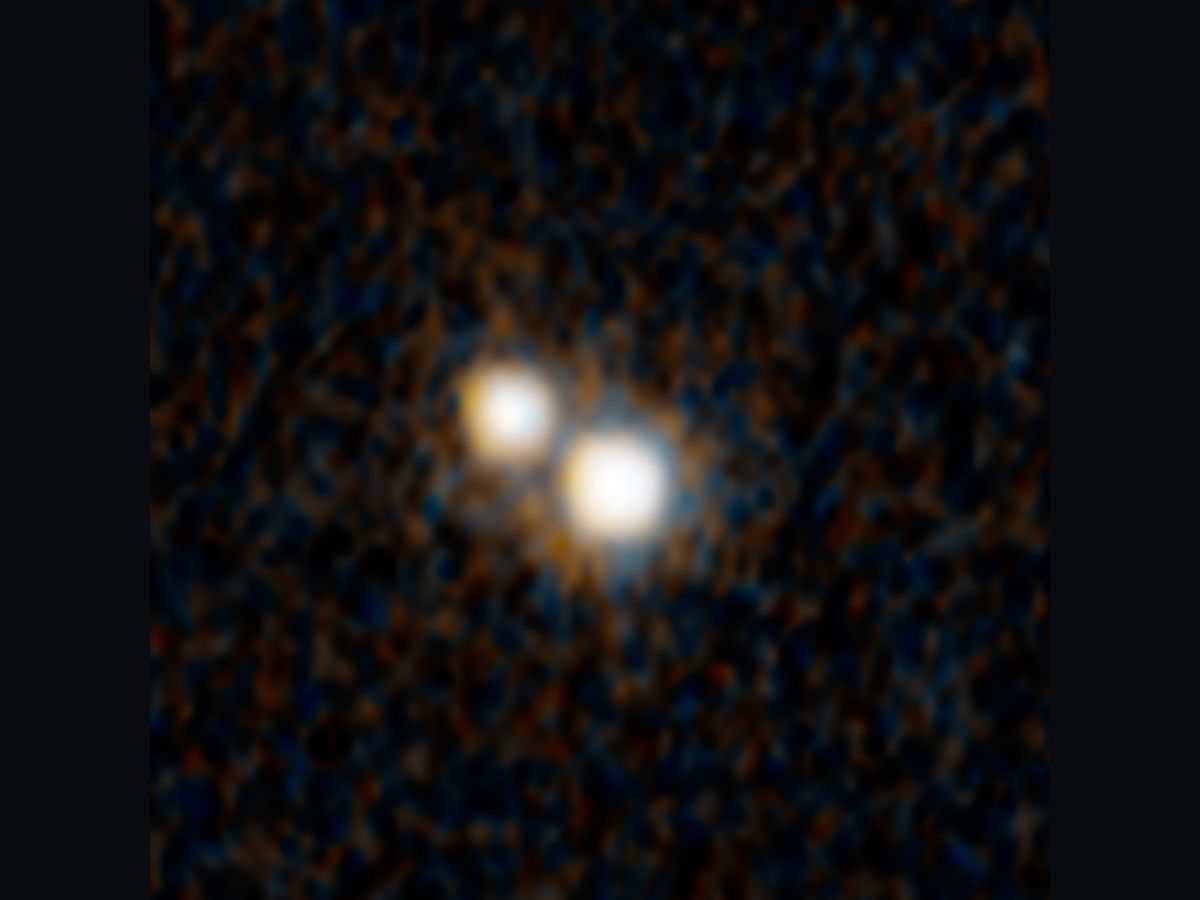An Unexpected Discovery: Hubble, ESA's Gaia Spot Double Quasar That Existed Over 10 Billion Years Ago
The two quasars are gravitationally bound, and are blazing away inside two merging galaxies. The double quasar existed around 10.7 billion years ago.

NASA's Hubble Space Telescope has helped astronomers make an unexpected discovery: a double quasar in the distant universe. The early universe was an exuberant place where galaxies collided into each other and even merged together. The double quasar was discovered using observations from Hubble and other space and ground-based observatories.
The European Space Agency's (ESA's) Gaia Space Observatory helped identify the double quasar in the first place.
When did the double quasar exist?
The two quasars are gravitationally bound, and are blazing away inside two merging galaxies. The double quasar existed around 10.7 billion years ago. The age of the universe is 13.7 billion years, which means that the double quasar existed when the universe was three billion years old. Therefore, the double quasar is from the early universe, and Hubble recently received light from the double quasar emitted 10.7 billion years ago.
What is a quasar?
A quasar is a special type of active galactic nucleus, which is present at the core of a galaxy, is powered by a supermassive black hole, and is extremely bright. The supermassive black holes powering quasars are extremely voracious, and blast out ferocious fountains of energy as they ingurgitate gas, dust and anything that comes in their vicinity.
The study describing the findings was published April 5 in the journal Nature.
What happens when galaxies merge?
The field of finding binary quasars is a relatively new area of research. It has just developed in the past 10 to 15 years. With the help of powerful observatories, astronomers are now able to identify the situations in which two quasars are active and at the same time, are close enough that they will eventually merge.
Most of the large galaxies formed through mergers of smaller systems. Within the merging galaxies, pairs of supermassive black holes can be formed. Eventually, these supermassive black holes can merge.
In a NASA statement, Yu-Ching Chen, the lead author on the paper, said one doesn't see a lot of double quasars in the early universe, which makes the new discovery so exciting.
Chen explained that knowing about the progenitor population of black holes will eventually tell astronomers about the emergence of supermassive black holes in the early universe, and frequent galactic mergers could be.
Xin Liu, one of the authors on the paper, said astronomers are starting to unveil this tip of the iceberg of the early binary quasar population.
Liu explained that the uniqueness of the study is that it is actually telling the world that an early binary quasar population exists. Astronomers now have a method to identify double quasars that are separated by less than the size of a single galaxy.
How was the double quasar discovered?
The discovery of the double quasar was a "needle-in-haystack search" that required the combined power of Hubble and the W M Keck Observatories in Hawaii. Astronomers also used multi-wavelength observations from NASA's Chandra X-ray Observatory, the International Gemini Observatory in Hawaii, and the National Science Foundation's Karl G Jansky Very Large Array telescope in New Mexico.
Chen explained that Hubble's sensitivity and resolution provided pictures that allowed astronomers to rule out other possibilities of what they were seeing. Hubble showed unequivocally that the structure is indeed a genuine pair of supermassive black holes, rather than two images of the same quasar created by a foreground gravitational lens.
According to the study, Hubble shows a tidal feature from the merging of two galaxies. A tidal feature is one which is created when gravity distorts the shape of the galaxies forming two tails of stars.

How did ESA’s Gaia help with the identification of the double quasar?
Since Hubble's sharp resolution alone is not good enough to search for dual light beacons, the researchers used Gaia to pinpoint potential double-quasar candidates. Gaia has the ability to make precise measurements of positions, distances and motions of nearby celestial bodies. Gaia can also be used to explore the distant universe.
This is because Gaia has a huge database which can be used to search for quasars that mimic the apparent motion of nearby stars. Since the two quasars are so close together, they appear as single objects in the Gaia data.
However, Gaia has the ability to pinpoint an unexpected "jiggle" that could occur due to an apparent change in the position of some of the quasars the observatory observes.
What are the challenges while observing quasars?
Quasars do not move through space in any measurable way. Instead of representing a change in the position of quasars, the jiggle could be evidence of random fluctuations of light. This is because the brightness of each member of the quasar paid could vary on a day-to-day or monthly basis, depending on the feeding behaviour of the black holes.
Another challenge while observing double quasars is that gravity warps space, because of which a foreground galaxy could split the image of a distant quasar into two. This could create an illusion of a single quasar being a double quasar. However, observations from the Keck Telescope proved that there was no galaxy acting as a gravitational lens between Earth and the suspected double quasar.
Does the double quasar still exist?
Since Hubble peered into the distant past, the double quasar no longer exists. According to NASA, the host galaxies of the two quasars have likely merged into a giant elliptical galaxy, over a period of more than 10 billion years.
What has happened to the double quasar now?
Also, there is a strong possibility that the quasars have merged to become a gargantuan, supermassive black hole at the centre of the elliptical galaxy.
How is M87, a nearby galaxy, likely to have formed?
M87 is a giant elliptical galaxy which is relatively near to Earth in astronomical terms. It has a gigantic black hole which weighs 6.5 billion times the mass of the Sun. The black hole is likely to have formed as a result of one or more galaxy mergers over the past billions of years.
What is next?
NASA's Nancy Grace Roman Space Telescope, which is scheduled to launch in May 2027, has the same visual acuity as Hubble, and is ideal for binary quasar hunting. Also, Roman's wide-angle infrared view of the universe is 200 times larger than that of Hubble.
Liu said that a lot of quasars out there could be binary systems, and the Roman Telescope can make huge improvements in the research area of double quasars.
Related Video
Southern Rising Summit 2024: How Important is Self-Awareness? Insights from Anu Aacharya | ABP LIVE






































